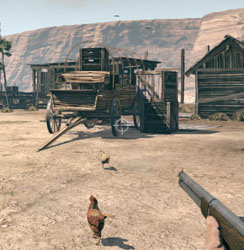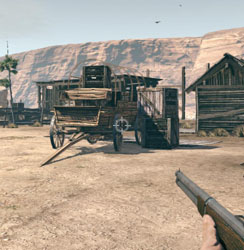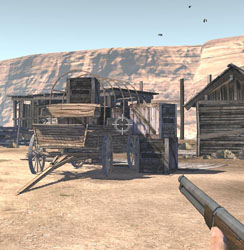Call of Juarez Graphics
Graphically, Call of Juarez: Bound in Blood is an incredibly impressive looking game, even if the actual content and setting doesn’t always give the new and enhanced Chrome 4 engine a chance to show what it can do. There aren’t any sizzling laser beams, gargantuan aliens or huge crowds to give the engine a stretch – there’s just dusty towns, rolling mesas and cowboys falling over balcony railings.That said, there are some areas of the game where Bound in Blood gets a chance to show off, especially in the open areas of the game that occasionally pop up between chapters. It’s here that you get a chance to roam the Wild West looking for secret areas and unlockables, provided you can dodge the bandits for long enough. These sections, while few, are truly huge and let the engine shine.
The most notable areas of the game from a technical standpoint are the lighting system and the quality of the textures though, not just the size of the levels. The textures are incredibly high quality, both on characters and in the environment, giving the game the same crisp and detailed look as the first Call of Juarez.
The lighting engine for the game is very powerful too with HDR support and complex shadows giving some relief to the endless beige of the desert. We were amazed at one point of the game when, while standing on a railway bridge over a deep canyon, we realised that we could look down and see our silhouette, which was fully dynamic and detailed, on the canyon floor.
The really good news though is that, even though the game looks better a party at the Playboy mansion as viewed through X-Ray specs, the actual system requirements for the game aren’t all that demanding. In fact, they’re pretty generic and the minimum requirements involve simply a P4 3.2GHz (or Pentium D 2.66 GHz, AMD Athlon 64 3500 + or better), 1GB of RAM (double that for Vista) and a graphics card with 256MB of memory with DirectX 9.0c and Shader Model 3.0 support – specs that we imagine most gamer rigs can easily manage with.
As it was, we ran Call of Juarez: Bound in Blood on all the best settings using our standard gaming rig (2.93GHz Core 2 Duo X6800 CPU, 3.25GB of accessible RAM and an Nvidia GeForce GTX 280) ran the game without any issues, with an average of around 40 frames per second. If you’re especially worried about the hardware requirements though then you check the monthly bit-tech.net buyers guide to get ideas about what to upgrade in both the enthusiast and budget price bands.



Left to Right: Call of Juarez: Bound in Blood on Best Quality, Balanced and Best Performance settings, click to enlarge
To help give you an idea of what the game might look like when running on your system we’ve included a few screenshots above that show what the game looks like on different settings. Unlike most multi-platform titles Call of Juarez: Bound in Blood isn’t just a lazy port either and players can tweak a number of different graphical options, change the keyboard layout and so on – you’re not fixed to just running the game as it might look on an Xbox 360.
That said, if you’re in a rush then the graphics menu does have three preset profiles and it’s these that we’ve taken screenshots of above – the Best Quality, Balanced and Best Performance presets. Quality obviously gives a prettier game, while Performance turns everything down or off if you’d rather have a smoother game and Balanced is a blend of the two.
At first glance you might not detect much of a difference between the three settings, as the textures still look pretty detailed and the shadows are still dynamic on the lower settings. It’s worth looking at the trees in the distance though to see that once you move out of the higher settings some of the cool post-processing effects, such as the heat haze and depth of field effect, disappear. While far from essential, these settings are an important part of the aesthetic in Call of Juarez and it’s worth making the push to enable them if you can.

MSI MPG Velox 100R Chassis Review
October 14 2021 | 15:04












Want to comment? Please log in.